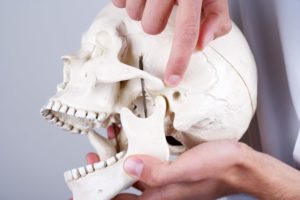TMJ/Neuromuscular Dentistry
Neuromuscular Dentistry in Bismarck & Garrison, ND
Many patients who complain of having jaw pain or difficulty chewing are unaware that a branch of dentistry called neuromuscular dentistry diagnoses and treat these symptoms. At Deeter Dental, our dentists have focused on neuromuscular dentistry in order to help you find relief from the pain you may have due to this condition.

What is Neuromuscular Dentistry?
Neuromuscular dentistry (physiologic dentistry) is the science of aligning the lower jaw in relation to the upper jaw while creating a balanced and relaxed musculature of the head and neck in the process, without any surgery! It specifically deals with the alignment of the jaw joint and how it interacts with the jaw and teeth as well as other parts of the head and neck. Neuromuscular dentists understand that repositioning the TMJ into correct alignment is the only solution for TMD.
What is TMJ or TMD?
TMJ stands for temporomandibular joint, and it is the ball-in-socket joint which connects your lower jaw to your skull. The TMJ is a complex system of bones, muscles, and tendons which controls not only how you open and close your mouth, but how you chew and speak. It may even affect your ear canals, shoulders and back. At Deeter Dental, part of caring for your whole mouth’s health includes recognizing TMJ disorders and treating them.
TMD, or temporomandibular joint disorder, is the misalignment of your jaw joint which can create problems with your bite and cause serious, debilitating pain. Because a misaligned jaw joint can cause severe and unnecessary damage to your teeth, it is important to undergo treatment for this serious condition. Many patients seek help from their general practitioners, chiropractors, and even neurologists, never realizing that the source of their discomfort is, in fact, their jaw joint. TMD is a fairly common problem that affects millions of people all over the world. TMD may be caused by genetics or by trauma to the jaw.
What’s the difference between TMD, TMJ, and TMJD?
Because the length of the word temporomandibular, this condition has many acronyms. They can be used somewhat interchangeably, but there is actually a difference between the three.
- TMJ stands for the temporomandibular joint.
- TMD stands for problems with said joint, temporomandibular joint disorder.
- TMJD is not really used.
Causes of Temporomandibular Joint Disorder (TMD)
Pretty much anything we do with our mouth involves the temporomandibular joint. It allows us to bite, chew, swallow, and talk. The joint combines a hinge action with sliding motions, forward and back and side-to-side.
Problems with the joint leading to TMD can often be traced back to misalignment of the patient’s bite, as that creates obvious stress because the joint is trying to align properly, but cannot. More subtle causes, such as clenching your teeth or grinding them at night due to stress, can also lead to TMD pain. Prior injury to the jaw can lead to TMD. There even appears to be a genetic predisposition to developing the condition.
Here are typical causes of TMD:
- Grinding teeth during sleep
- Clenching the teeth
- Movement of the soft cushion (disc) between the ball and socket of the joint
- Arthritis in the joint
- Stress, which can cause a person to tighten facial and jaw muscles
- Traumatic injury to the jaw
Is TMD serious?
Temporomandibular joint disorder is not life-threatening and can be lived with, so many patients don’t bother treating the condition. But TMD can cause continual pain and to most people that is a serious issue. This disorder can lead to chronic pain that can radiate far away from the joint. We have patients with pain and tenderness across their face, in the jaw joint area, the neck and shoulders, even in the ears. Headaches are common. Some patients even find their TMD creates dizziness. TMD pain can be life affecting and damaging.
How is TMD Diagnosed?
Dr. Lucas Deeter has extensive training and experience diagnosing and treating TMD. This is important, as many dentists and doctors attribute the signs and symptoms of TMD to other incorrect causes. When searching for a reason behind a patient’s jaw and neck pain, Dr. Deeter first eliminates other conditions that can create the same symptoms: tooth decay, gum disease, arthritis, even sinus infections. From there he checks for areas of tenderness around the jaw joints. This is a sign that the muscles are being overworked. We’ll have you open and close your jaw, listening for the clicking, popping, and grating sounds typical with TMD.
We also use these tests to identify TMD:
- Full-face x-rays, MRIs, or CT scans — These may be used to view the position of the jaw and temporomandibular joints.
- Sonography – Sound waves are used to determine whether there are any problems with jaw alignment. Dr. Deeter also listens for any abnormal sounds emanating from the jaw.
- Electromyography (EMG) – This method uses the electricity generated by jaw muscles to measure both muscle and nerve function. It can help to see when there is a reaction (such as pain) to movement.
- Computerized test equipment — This is used to measure the correct resting position of the jaw, identifying misalignment problems.
Symptoms of Misaligned TMJ
You may be suffering from a misaligned TMJ if you experience one or more of the following symptoms:
- Sore jaw or teeth
- Grinding teeth
- Unexplained headaches
- Neck, shoulder, or back pain
- Ringing in ears
- Dizziness or vision problems
- Popping, clicking or grinding sounds in the jaw
- Jaw stiffness or immobility
While these symptoms are not always indicators of TMD, they are frequently found in patients suffering from TMD. Many patients find that their symptoms are alleviated almost immediately once they have begun treatment.
TMJ Treatment Options
At Deeter Dental, we take pride in helping patients get past their TMD. The treatment of TMD may vary somewhat from patient to patient. This depends on the severity of the misalignment and on the symptoms you exhibiOur approaches to your treatment can range from corrective dentistry to creating a night guard to wear during sleep.
Here are the treatments we use to correct TMD:
-
- Splints or night guards — Night grinding and clenching is a main factor in TMD. To combat this, it’s important to put the jaw in the correct position at night. To do this, we fabricate plastic mouthpieces that fit over the upper and lower teeth. These are usually worn only at night.
- Transcutaneous electrical nerve stimulation (TENS) — Small electrical pulses are delivered to the jaw muscles through a small wand. These pulses stimulate the nerves, encouraging the muscles to relax and the jaw to fall into alignment. This treatment may sound painful, but the impulses feel somewhat similar to a massage.
- Cosmetic dentistry — To correct alignment, we can replace missing teeth with dental implants or bridges, crown overly worn teeth, or move the teeth with orthodontics. This can involve widening constricted arches with our Controlled Arch system.
- Lifestyle changes — Stress and anxiety are often root causes of TMD; stress reduction techniques are important.
- Exercises — Tightening the jaw muscles and clenching the teeth is a common cause of TMD problems. We have various jaw exercises that stimulate and relax the jaw muscles.
Can my TMD go away on its own?
Some people do nothing about the pain from their TMD, hoping it will resolve on its own. If stress is behind your case, that could work if you eliminate the stressors in your life. But if your bite is misaligned, that’s not going anywhere without treatment. You need to remember that fixing alignment doesn’t necessarily involve protracted procedures. Sometimes, Dr. Deeter can simply create a custom mouth guard that you wear at night and that solves your problems. Living with pain from ongoing TMD just isn’t worth it.
Does TMD ever require surgery?
In the vast majority of cases, therapies such as oral splints, physical therapy, and behavior modification usually are effective for managing and reversing TMD. But in more extreme instances, surgery may be necessary to correct structural problems. We do not perform these surgeries at Deeter Dental, but can refer you to an oral surgeon. Again, surgery for TMD is rarely necessary.
- TMJ arthroscopy — If arthroscopy can be used, it is preferred because it creates fewer possible complications. A cannula is placed into the joint space, followed by an arthroscope to provide visuals. Then small surgical instruments are used for surgery.
- Condylotomy — This is surgery to the jaw, but not the temporomandibular joint. This can be effective if the patient is experiencing jaw locking.
- Open-joint surgery — Open-joint surgery is necessary to address structural issues with the joint. In some cases, the articular disc that cushions the jaw joint may need to be replaced with an artificial disc.
Physiologic Dentistry For Headaches
You may still wonder how physiologic dentistry can resolve your headache pain without medications. The secret is understanding that nothing in your body is separate. Your jaw muscles are the largest muscles in your head. When they’re not functioning properly everything in your neck and head can be thrown off balance. You can experience tension headaches, sore neck, and upper back pain for starters.
The nerve that commands your muscles is the trigeminal nerve, which is cranial nerve 5. This one single nerve commands 60% of all the input and output of the 12 cranial nerves. Most migraines and headaches are related to the muscles controlled by the trigeminal nerve. Some doctors want to treat this by cutting away these muscles or using drugs to relax them, but physiologic dentistry has a better solution. By helping your jaw find a tension-free position, we can reduce your headaches and migraines without drugs.
Schedule a Consultation
If you suffer from the symptoms of TMD, please contact our Bismarck neuromuscular dentists today to schedule an appointment. Call our Bismarck office at 701.222.1800 or our Garrison office at 701.463.2884. We welcome patients from Bismarck, North Dakota and surrounding areas.




